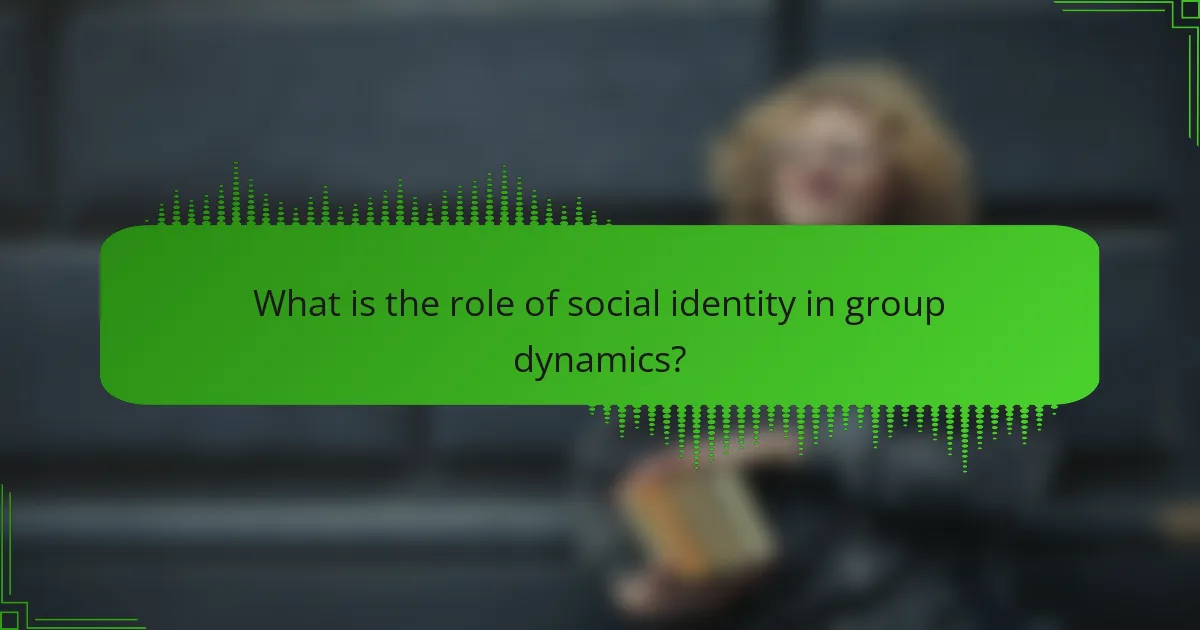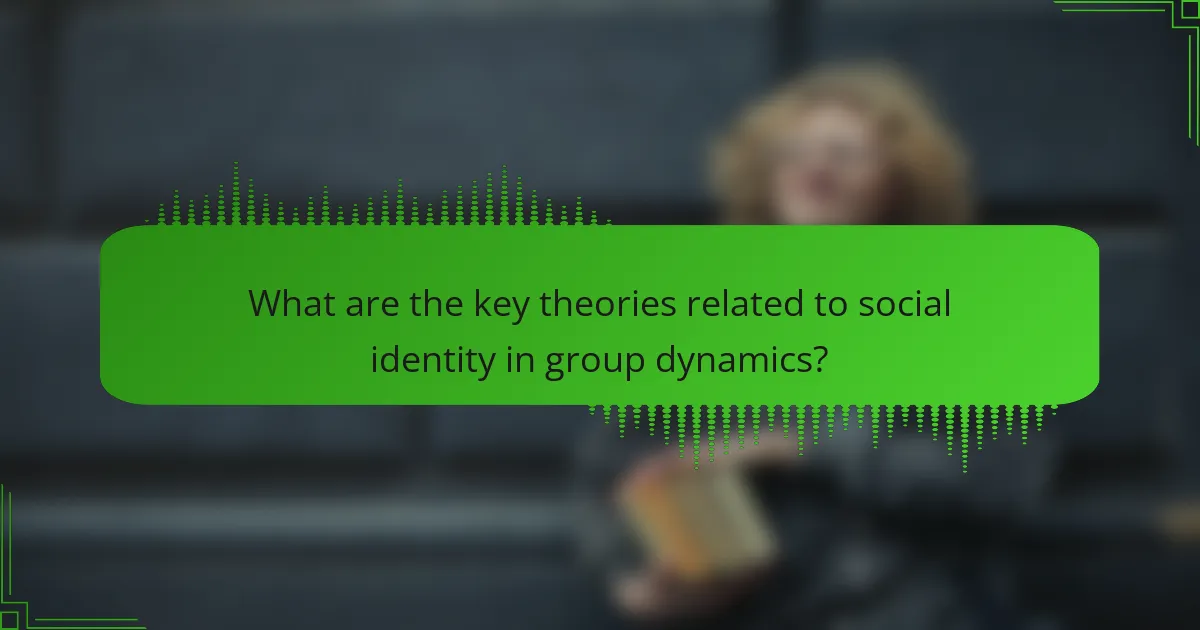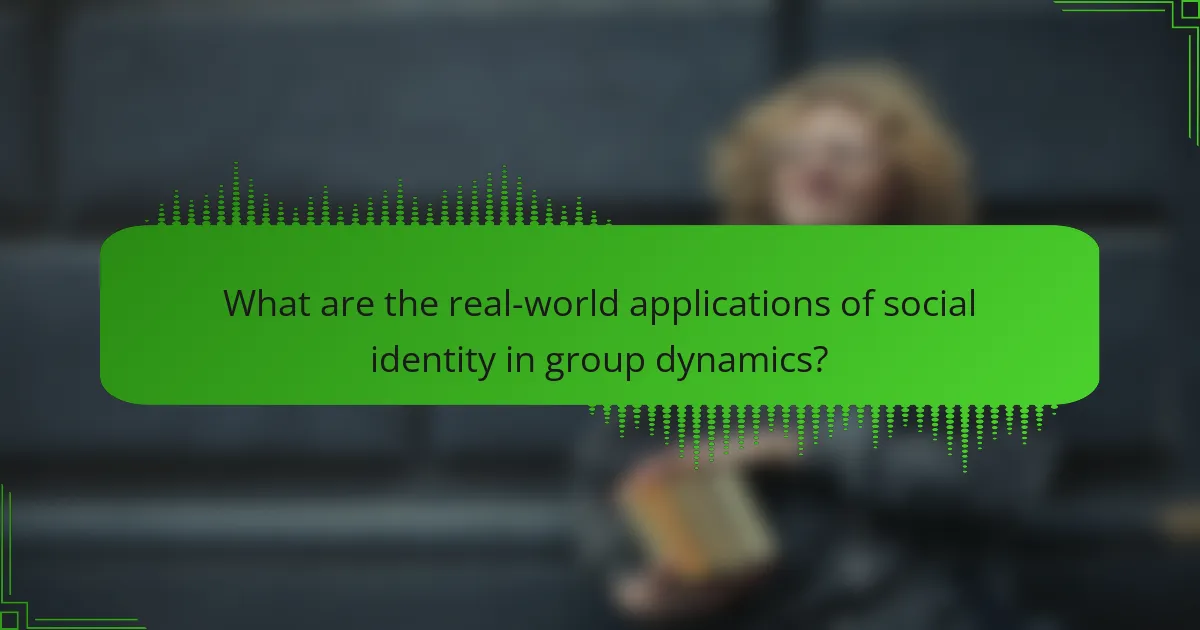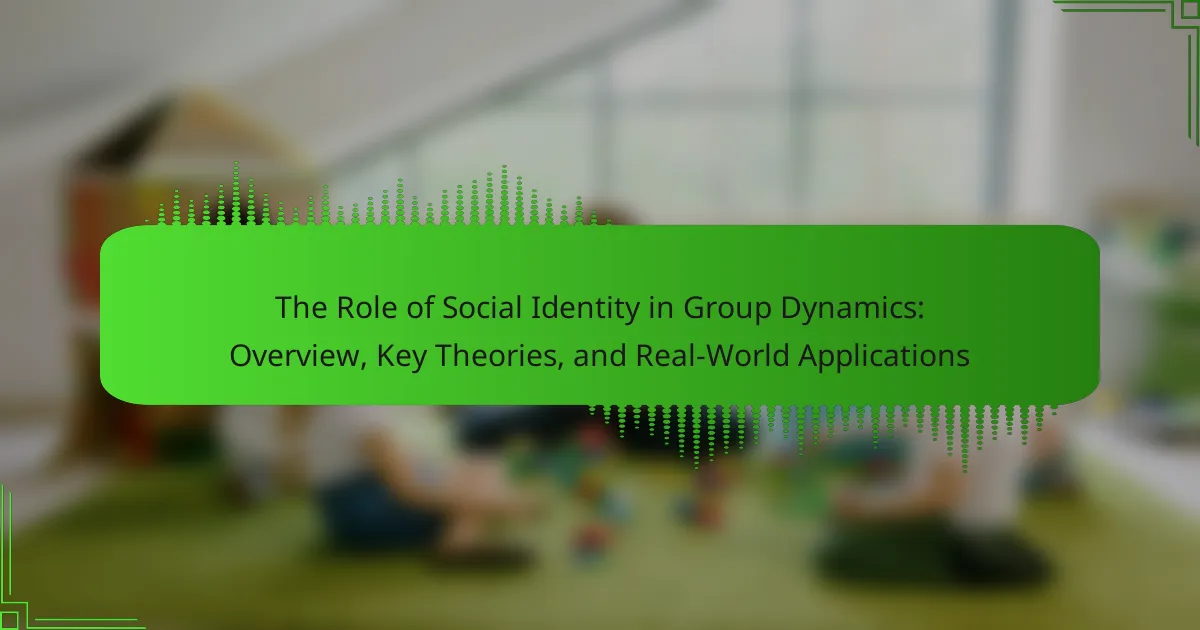Social identity is a critical factor in group dynamics, influencing individual behavior and interactions within groups. It shapes self-perception and perceptions of others, enhancing group cohesion and motivation towards shared goals. Key theories, including Social Identity Theory and Self-Categorization Theory, explain how group memberships impact behavior and social interactions. The article explores the significance of social identity in various contexts, such as organizational performance, educational settings, sports, community engagement, and marketing, highlighting its role in fostering cooperation and achieving collective objectives.

What is the role of social identity in group dynamics?
Social identity plays a crucial role in group dynamics by influencing individuals’ behavior and interaction within a group. It shapes how members perceive themselves and others. This perception affects group cohesion and solidarity. Social identity fosters a sense of belonging, which enhances motivation and commitment to group goals. Research indicates that strong social identities lead to increased cooperation among group members. For example, in a study by Henri Tajfel, individuals categorized into groups displayed favoritism towards in-group members. This behavior illustrates how social identity can drive group dynamics. Therefore, social identity is fundamental in shaping interactions, influencing outcomes, and enhancing group performance.
How does social identity influence individual behavior within groups?
Social identity significantly influences individual behavior within groups by shaping perceptions and interactions. Individuals identify with specific groups, which affects their attitudes and actions. This identification fosters in-group favoritism, leading to preferential treatment of fellow group members. Conversely, it can also result in out-group bias, where individuals may act negatively towards those outside their group. Research shows that social identity can enhance cooperation and solidarity among group members. A study by Tajfel and Turner (1979) demonstrates that mere categorization into groups can lead to discrimination favoring the in-group. This illustrates how social identity directly impacts behavior in group settings.
What are the psychological mechanisms behind social identity?
Social identity is shaped by psychological mechanisms such as categorization, social comparison, and self-esteem enhancement. Categorization involves grouping individuals into social categories, which simplifies social perception. This process helps individuals identify with certain groups while distancing from others. Social comparison occurs when individuals evaluate themselves against group norms or other groups. This comparison can boost self-esteem if one’s group is perceived positively. Self-esteem enhancement is a key driver of social identity, as belonging to a valued group can improve individual self-worth. Research by Henri Tajfel on social identity theory supports these mechanisms. Tajfel’s experiments demonstrated how group membership influences attitudes and behaviors. These psychological mechanisms play a crucial role in shaping group dynamics and individual identity.
How does social identity shape group cohesion?
Social identity shapes group cohesion by creating a shared sense of belonging among members. This shared identity fosters emotional connections and mutual support. When individuals identify with a group, they are more likely to collaborate and work towards common goals. Research indicates that strong social identities enhance trust and reduce conflict within groups. For example, a study by Tajfel and Turner (1979) highlights how categorization into groups can lead to in-group favoritism. This favoritism strengthens bonds among group members and promotes cooperative behavior. Overall, social identity serves as a foundation for unity and collective action within groups.
Why is understanding social identity important in group dynamics?
Understanding social identity is crucial in group dynamics because it shapes individual behavior and group cohesion. Social identity influences how members perceive themselves and others within the group. It affects communication patterns, decision-making, and conflict resolution. Groups with a strong social identity tend to have higher levels of trust and cooperation. Research shows that social identity fosters a sense of belonging, which enhances group performance. For instance, studies indicate that teams with a clear social identity outperform those without it. Understanding social identity helps leaders manage diversity and promote inclusion effectively.
What impact does social identity have on group decision-making?
Social identity significantly influences group decision-making. It shapes how individuals perceive themselves and others within the group. Members often prioritize group goals over personal interests. This alignment can enhance cohesion and collaboration. Research shows that individuals are more likely to conform to group norms when they strongly identify with the group. For instance, a study by Tajfel and Turner (1979) highlights how social identity affects in-group favoritism. This can lead to biased decision-making, as members may overlook critical information that contradicts group beliefs. Furthermore, social identity can create conflict with out-groups, impacting overall group dynamics and decisions.
How can social identity affect conflict within groups?
Social identity can significantly affect conflict within groups by creating in-group and out-group dynamics. When individuals identify strongly with their group, they may perceive members of other groups as threats. This perception can lead to competition for resources, status, or recognition. Research shows that social identity influences attitudes and behaviors during conflicts. For example, the Minimal Group Paradigm demonstrates that even arbitrary group distinctions can trigger bias and hostility. Additionally, social identity can lead to heightened loyalty among in-group members, exacerbating tensions with out-group members. This dynamic often results in misunderstandings and escalated conflicts, undermining collaboration and cohesion.

What are the key theories related to social identity in group dynamics?
Key theories related to social identity in group dynamics include Social Identity Theory and Self-Categorization Theory. Social Identity Theory, developed by Henri Tajfel, posits that individuals derive part of their self-concept from group memberships. This theory explains in-group favoritism and out-group discrimination. Self-Categorization Theory, proposed by John Turner, expands on this by exploring how individuals categorize themselves and others into groups. This categorization influences behavior and perceptions within social contexts. Both theories emphasize the significance of group identity in shaping social interactions and group behavior. Research by Tajfel and Turner in the 1970s provides empirical support for these theories, demonstrating their relevance in understanding group dynamics.
How does Social Identity Theory explain group behavior?
Social Identity Theory explains group behavior by emphasizing the role of group membership in shaping individual identity. It posits that individuals categorize themselves and others into social groups. This categorization fosters in-group favoritism and out-group discrimination. People derive self-esteem from their group affiliations. This leads to a preference for members of one’s own group. Research shows that group dynamics can influence behavior and attitudes significantly. For example, studies demonstrate that individuals conform to group norms to maintain social identity. The theory is supported by empirical evidence, including Tajfel’s experiments, which illustrate how minimal group distinctions can lead to bias.
What are the main components of Social Identity Theory?
The main components of Social Identity Theory are social categorization, social identification, and social comparison. Social categorization involves classifying individuals into groups based on shared characteristics. This process simplifies social perception and helps individuals understand their social environment. Social identification occurs when individuals adopt the identity of the group they belong to. This enhances self-esteem and fosters a sense of belonging. Social comparison involves evaluating one’s group against others. This can lead to in-group favoritism and out-group discrimination. These components work together to shape an individual’s social identity and influence group dynamics.
How does Social Identity Theory relate to in-group and out-group dynamics?
Social Identity Theory explains how individuals categorize themselves and others into groups. This categorization results in the formation of in-groups and out-groups. In-groups are those groups to which an individual identifies, while out-groups consist of those they do not identify with. This theory posits that individuals derive self-esteem from their in-group affiliations. Consequently, this can lead to favoritism towards in-group members and discrimination against out-group members. Research has shown that this dynamic can enhance group cohesion but also foster intergroup conflict. The theory highlights the psychological mechanisms behind social categorization and its impact on behavior and attitudes towards others.
What is Self-Categorization Theory and its significance?
Self-Categorization Theory is a psychological framework that explains how individuals classify themselves and others into social groups. It emphasizes the role of social identity in shaping behavior and perceptions. This theory posits that people define themselves based on group memberships, leading to in-group favoritism and out-group discrimination. The significance of Self-Categorization Theory lies in its ability to enhance understanding of group dynamics. It informs various fields, including social psychology, organizational behavior, and political science. Research indicates that self-categorization influences decision-making and interpersonal interactions. This framework aids in addressing social issues, promoting diversity, and improving group cohesion.
How does Self-Categorization Theory differ from Social Identity Theory?
Self-Categorization Theory differs from Social Identity Theory in its focus on cognitive processes. Self-Categorization Theory emphasizes how individuals classify themselves into social groups based on situational contexts. It explains the psychological mechanisms behind group behavior and identity formation. In contrast, Social Identity Theory concentrates on the social and emotional aspects of group membership. It highlights the impact of group identity on self-esteem and intergroup relations. Research indicates that Self-Categorization Theory provides a framework for understanding the fluidity of identity. Social Identity Theory, however, focuses on the stability of group identities over time. Both theories contribute to understanding group dynamics but approach the concept of identity from different angles.
What role does self-categorization play in group identity formation?
Self-categorization is crucial in group identity formation. It allows individuals to define themselves in relation to others. This process helps establish a sense of belonging to a specific social group. As individuals categorize themselves, they adopt the norms and values of that group. Research indicates that self-categorization enhances group cohesion. For example, studies show that individuals who identify strongly with a group are more likely to cooperate and support each other. This behavior reinforces the group’s identity and strengthens interpersonal bonds. Self-categorization ultimately shapes how individuals perceive themselves and their roles within the group.

What are the real-world applications of social identity in group dynamics?
Social identity plays a crucial role in shaping group dynamics in various real-world applications. It influences team performance in organizations, where shared identities enhance collaboration and communication. In educational settings, social identity affects peer interactions and academic motivation among students.
In sports, team identity fosters unity and enhances performance through shared goals. Social identity also impacts community engagement, as individuals with a strong group identity are more likely to participate in local initiatives.
Additionally, social identity is significant in marketing, where brands leverage group affiliations to build loyalty among consumers. Research shows that consumers often identify with brands that reflect their social identity, influencing purchasing behavior.
Overall, social identity is a fundamental aspect of group dynamics across diverse contexts, facilitating cooperation and shared objectives.
How is social identity utilized in organizational settings?
Social identity is utilized in organizational settings to enhance group cohesion and employee engagement. Organizations leverage social identity to foster a sense of belonging among employees. This belonging can lead to increased motivation and productivity. Employees who identify strongly with their organization are more likely to exhibit loyalty. Research shows that social identity influences team dynamics and collaboration. For instance, members of cohesive teams communicate more effectively. They also resolve conflicts more efficiently. Studies indicate that a strong social identity can improve overall organizational performance.
What strategies can organizations implement to leverage social identity?
Organizations can implement several strategies to leverage social identity effectively. First, they can foster a sense of belonging among employees. This can be achieved through team-building activities that promote shared experiences. Second, organizations can emphasize shared values and goals. Clear communication of these values can strengthen group cohesion. Third, they can create inclusive environments that celebrate diversity. This approach encourages individuals to embrace their unique identities within the group context. Fourth, organizations can utilize social identity in branding. Aligning brand messaging with the social identities of target audiences can enhance customer loyalty. Fifth, they can encourage employee participation in decision-making. This practice empowers individuals and reinforces their connection to the organization. Research supports these strategies, showing that social identity influences motivation and engagement in workplace settings.
How does social identity impact team performance in the workplace?
Social identity significantly impacts team performance in the workplace by influencing collaboration and cohesion among members. When individuals identify strongly with their team, they tend to exhibit higher levels of commitment and motivation. This shared identity fosters trust and open communication, which are essential for effective teamwork. Research indicates that teams with a strong social identity outperform those without it. A study by Haslam et al. (2009) found that shared social identity enhances group performance by promoting cooperation and reducing conflict. Furthermore, teams that embrace diversity in social identities can leverage varied perspectives, leading to more innovative solutions. Overall, social identity shapes team dynamics, directly affecting productivity and success.
What role does social identity play in community and social movements?
Social identity plays a crucial role in shaping community and social movements. It influences group cohesion and solidarity among members. Strong social identities encourage collective action and mobilization. Individuals often align their beliefs and behaviors with their social groups. This alignment fosters a sense of belonging and purpose. Research shows that shared social identities can enhance commitment to movement goals. For example, the Civil Rights Movement was driven by a shared identity among African Americans. This identity united individuals in their struggle for equality and justice. Thus, social identity is foundational for the formation and success of community and social movements.
How can social identity foster collective action?
Social identity can foster collective action by creating a sense of belonging among group members. This shared identity motivates individuals to work together toward common goals. When people identify with a group, they are more likely to engage in behaviors that benefit the group. Research shows that social identity enhances cooperation and reduces free-riding. For example, the social identity theory suggests that group membership influences individual behavior. Additionally, collective efficacy, which is the belief in the group’s ability to achieve goals, is strengthened by social identity. This belief encourages participation and commitment to group initiatives.
What examples illustrate the impact of social identity in social change?
Social identity significantly influences social change through various movements. The Civil Rights Movement in the United States is a prime example. It was driven by African Americans’ collective identity and the fight against racial segregation. This movement led to landmark legislation, such as the Civil Rights Act of 1964.
Another example is the Women’s Suffrage Movement. Women united under a shared identity to demand voting rights. This collective action resulted in the 19th Amendment, granting women the right to vote in 1920.
Additionally, [censured] rights movements illustrate social identity’s impact. The Stonewall Riots in 1969 marked a pivotal moment for [censured] visibility and rights. This collective identity fostered ongoing advocacy for equality and legal protections.
These examples demonstrate how social identity can mobilize groups to effect meaningful change in society.
What practical tips can enhance understanding of social identity in group dynamics?
To enhance understanding of social identity in group dynamics, encourage open discussions about identity. These discussions help members articulate their backgrounds and experiences. Facilitate team-building exercises that highlight diversity. Such activities foster appreciation for different perspectives. Implement training sessions focused on social identity theories. This education can deepen awareness of group behaviors. Encourage reflection on personal and group identities. Self-awareness contributes to better group interactions. Use case studies to illustrate social identity impacts in real scenarios. This approach provides concrete examples for better comprehension.
The main entity of the article is social identity, which plays a significant role in group dynamics by influencing individual behavior, group cohesion, and decision-making processes. The article explores key theories such as Social Identity Theory and Self-Categorization Theory, highlighting how these frameworks explain in-group favoritism and intergroup dynamics. It also examines the psychological mechanisms behind social identity, its impact on conflict and collaboration within groups, and its real-world applications in organizational settings, community movements, and social change initiatives. Overall, the article provides a comprehensive overview of how social identity shapes interactions, enhances group performance, and fosters collective action across various contexts.



